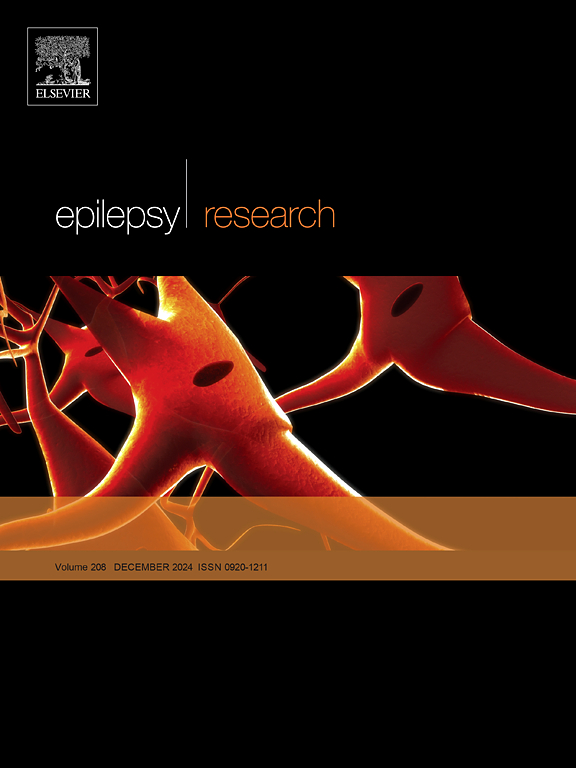基于总脑电图评分的间期脑电图分析在早期评估癫痫患者认知功能障碍中的意义。
IF 2
4区 医学
Q3 CLINICAL NEUROLOGY
引用次数: 0
摘要
目的:癫痫是一种广泛存在的神经系统疾病,可增加认知障碍(CI)或痴呆的风险。我们的目的是评估认知与癫痫患者间期脑电图(EEG)之间的关系,采用总脑电图(GTE)评分。此外,我们研究了GTE评分在这些患者CI早期检测中的效用。方法:对扬州大学附属医院确诊的93例不明原因癫痫患者的资料进行分析。进行脑电图记录和认知评估。根据蒙特利尔认知评估(MoCA)评分将患者分为三组:正常认知(NC)组、轻度认知障碍(MCI)组和痴呆组。该研究包括分析认知测试结果与临床特征之间的相关性。此外,还考察了GTE分数和分项分数对认知的影响。统计分析包括单因素方差分析(ANOVA)、Kruskal-Wallis h检验、Mann-Whitney u检验、卡方检验、Spearman秩相关分析和多元线性回归。结果:(1)认知测验成绩与GTE成绩呈显著负相关。认知(MoCA)与GTE评分呈显著负相关(ρ = -0.754, P )。结论:GTE评分为癫痫患者CI的早期检测提供了有临床价值的信息。随着癫痫患者CI的恶化,GTE评分、弥漫性慢活动、节律性背景活动频率和发作性活动增加。医疗保健提供者不仅应该关注癫痫发作,还应该关注间断性脑电图异常,以预防或减轻CI的风险。本文章由计算机程序翻译,如有差异,请以英文原文为准。
The significance of interictal electroencephalogram analysis based on the grand total electroencephalogram score in early assessment of cognitive impairment in epilepsy patients
Purpose
Epilepsy is a widespread neurological disorder that increases the risk of cognitive impairment (CI) or dementia. We aimed to assess the relationship between cognition and interictal electroencephalogram (EEG) in epilepsy patients, using the Grand Total EEG (GTE) score. Additionally, we investigated the GTE score's utility in the early detection of CI in these patients.
Methods
Data from 93 patients diagnosed with unexplained epilepsy at the Affiliated Hospital of Yangzhou University were analyzed. EEG recordings and cognitive evaluations were performed. Patients were categorized into three groups based on their Montreal Cognitive Assessment (MoCA) scores: normal cognitive (NC) group, mild cognitive impairment (MCI) group, and dementia group. The study included analysis of correlations between cognitive test results and clinical characteristics. Additionally, the influence of GTE scores and subscores on cognition was examined. Statistical analyses included one-way analysis of variance (ANOVA), Kruskal-Wallis H-test, Mann-Whitney U-test, Chi-square test, Spearman rank correlation analysis, and multiple linear regression.
Results
(1) There was a significant negative correlation between cognitive test scores and GTE scores. Strong negative correlations were found between cognition (MoCA) and the GTE score (ρ = −0.754, P < 0.001), as well as for the subscores "Diffuse Slow Activity" (ρ = −0.712, P < 0.001), "Frequency of Rhythmic Background Activity" (ρ = −0.490, P < 0.001), and "Paroxysmal Activity" (ρ = −0.565, P < 0.001). (2) Multiple linear regression analysis identified the GTE score, "Diffuse Slow Activity", "Paroxysmal Activity", age, and education as significant predictors of cognitive decline. (3) At a threshold of 4.5, the GTE score effectively differentiated between individuals with and without CI, demonstrating a sensitivity of 73.8 % and a specificity of 93.7 %.
Conclusion
The GTE score provides clinically valuable information for the early detection of CI in patients with epilepsy. As CI worsens in epilepsy patients, the GTE score, Diffuse Slow Activity, Frequency of Rhythmic Background Activity, and Paroxysmal Activity increase. Healthcare providers should focus on managing not only seizures but also interictal EEG abnormalities to prevent or mitigate the risk of CI.
求助全文
通过发布文献求助,成功后即可免费获取论文全文。
去求助
来源期刊

Epilepsy Research
医学-临床神经学
CiteScore
0.10
自引率
4.50%
发文量
143
审稿时长
62 days
期刊介绍:
Epilepsy Research provides for publication of high quality articles in both basic and clinical epilepsy research, with a special emphasis on translational research that ultimately relates to epilepsy as a human condition. The journal is intended to provide a forum for reporting the best and most rigorous epilepsy research from all disciplines ranging from biophysics and molecular biology to epidemiological and psychosocial research. As such the journal will publish original papers relevant to epilepsy from any scientific discipline and also studies of a multidisciplinary nature. Clinical and experimental research papers adopting fresh conceptual approaches to the study of epilepsy and its treatment are encouraged. The overriding criteria for publication are novelty, significant clinical or experimental relevance, and interest to a multidisciplinary audience in the broad arena of epilepsy. Review articles focused on any topic of epilepsy research will also be considered, but only if they present an exceptionally clear synthesis of current knowledge and future directions of a research area, based on a critical assessment of the available data or on hypotheses that are likely to stimulate more critical thinking and further advances in an area of epilepsy research.
 求助内容:
求助内容: 应助结果提醒方式:
应助结果提醒方式:


